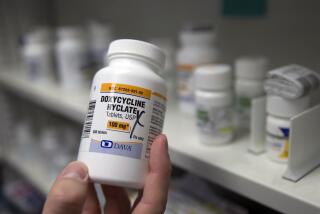AIDS Rate for Gay Men Climbs
- Share via
The number of newly diagnosed HIV and AIDS cases among gay and bisexual men grew 11% in the four-year period ending in 2003, raising fears of a new outbreak of the disease in a group experts said had become increasingly casual about taking protective measures.
The increase was offset by a decline in new cases among intravenous drug users, so the overall rate increased by 1% over the same period, according to new data from the Centers for Disease Control and Prevention released Wednesday on World AIDS Day.
The CDC estimates that about 40,000 new HIV infections occur each year in the U.S., and that between 850,000 and 950,000 Americans are living with the disease, with about 280,000 not knowing they are infected, said Dr. Ronald O. Valdiserri, deputy director of the CDC’s HIV prevention program. About 18,000 die of AIDS each year in the U.S.
The number of new infections has remained stable since the mid-1990s, when the burgeoning use of anti-HIV drugs lowered virus transmissions and death. But the mark is seen as a setback because the government had set the goal of cutting the rate of new infections in half by 2005.
“We have a ways to go before we reach [that] mark,” Valdiserri said in a telephone briefing with reporters.
“It’s simply unacceptable that so many people continue to be infected by this virus,” said Dr. Julie Gerberding, director of the CDC.
Men who have sex with men bore the initial brunt of the AIDS epidemic and account for 44% of newly diagnosed cases, according to the new data. But complacency brought on by effective AIDS drugs and the time that had elapsed since the initial ravages of the epidemic had led to an increase in unsafe sex practices, officials said.
Data released by the CDC this week showed that syphilis rates -- considered a good barometer of unsafe sex practices -- were up nationwide for the third year in a row after a decade of decline.
“We need to pay close attention to this population and find new ways to intervene,” Valdiserri said. “This is not a trend we want to ignore.”
The new HIV data are based on information obtained from 32 states that keep detailed infection records and include the names of patients. The 32 states account for about half of all HIV and AIDS cases in the country.
California and New York are not included among the reporting states, but Valdiserri said the agency believed its estimates accurately reflected the situation nationwide.
The data continue to show racial disparities. African Americans represent 51% of the new diagnoses, though they account for 13% of the nation’s population. The rate among black men was seven times the rate among white men and three times the rate among Latino men.
Black women account for 69% of new diagnoses among females. The rate is 18 times that of white women and five times the rate among Latinas.
“The number of women of color in the United States that continue to be affected by this devastating disease is quite sobering,” said Health and Human Services Secretary Tommy G. Thompson.
Until last year, prevention efforts were focused on identifying people who were infected by the virus but did not know it, on the theory that identifying the infection would cause them to restrict their sexual activity. According to the data released Wednesday, about 10% of Americans had an HIV test last year, a number that has remained stable since 1992.
More recently, the government has targeted those known to be infected.
More to Read
Sign up for Essential California
The most important California stories and recommendations in your inbox every morning.
You may occasionally receive promotional content from the Los Angeles Times.










